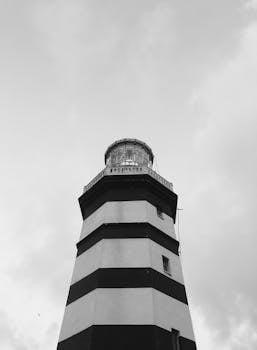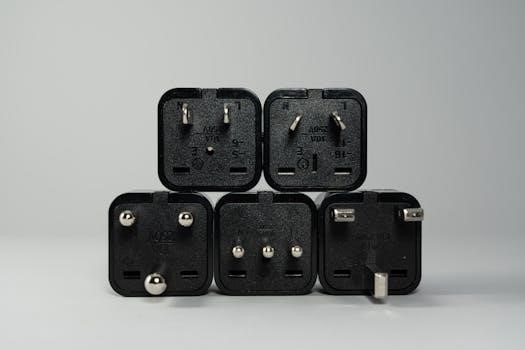Common Goodman AC Problems
Goodman air conditioners, while reliable, can experience issues. Common problems include the unit not turning on, weak airflow due to clogged filters, and inadequate cooling caused by various factors, such as dirty coils or refrigerant leaks.

AC Unit Not Turning On
A frequent issue with Goodman AC units is the failure to power on. This can stem from several causes, including a faulty power supply to the unit or thermostat malfunctions. Begin by checking the circuit breaker to ensure it hasn’t tripped. Verify that the power switch is in the on position. A blown fuse in the electrical panel could also be the culprit, requiring a replacement. Additionally, inspect the thermostat settings and batteries for proper functionality. If the thermostat display is blank, replace the batteries or address any wiring problems. Sometimes a simple reset by turning the power off, waiting, and turning it back on can resolve the issue. If these basic checks don’t resolve the problem, professional assistance might be necessary to diagnose further electrical problems.
Weak Airflow Issues
Experiencing weak airflow from your Goodman AC unit is a common concern, often indicating a blockage or restriction. The primary culprit is typically a dirty air filter. Clogged filters impede airflow, significantly reducing the unit’s efficiency. Regularly replace air filters to maintain proper ventilation. Ensure all air registers are fully open, allowing for unobstructed airflow throughout the system. Additionally, check for any obstructions in the ductwork, such as collapsed or disconnected sections. If the evaporator coil is frozen, this can also reduce airflow; investigate potential causes such as low refrigerant levels or a faulty capacitor. A dirty blower wheel can also hinder airflow. If these steps don’t improve the airflow, a professional technician may be needed to inspect the ductwork or blower motor.
AC Not Cooling Properly
When your Goodman AC fails to cool effectively, several factors could be at play. A dirty air filter is a common cause, hindering airflow and reducing cooling capacity. Check and replace the filter regularly. Insufficient refrigerant levels due to leaks can also impair cooling. Dirty evaporator or condenser coils prevent heat transfer, necessitating professional cleaning. Examine the thermostat settings to ensure they are correctly configured. A faulty capacitor can affect compressor operation, leading to poor cooling. Additionally, ensure that the condenser unit is free from obstructions. Improper system installation or maintenance history can contribute to these issues; If these steps don’t solve the problem, a professional HVAC technician should diagnose and repair the system for optimal performance.

Troubleshooting Steps
When facing issues with your Goodman AC, start by resetting the system, checking and replacing air filters, and examining the circuit breaker for any trips. These simple actions can often resolve common problems.
Resetting the System
If your Goodman air conditioner suddenly stops working, a simple system reset is often the first and easiest troubleshooting step to try. This process can resolve minor glitches and restore the unit to normal operation. To reset your Goodman AC, begin by locating the power switch on the unit, which is usually a dedicated switch near the outdoor condenser unit. Once you have found the power switch, turn the air conditioner off completely. It is crucial to wait for at least 30 seconds to allow any residual electrical charge to dissipate. After the waiting period, turn the unit back on using the power switch. This simple reset procedure can often fix many common issues. This reset does not involve any complex procedures and is a great starting point for any troubleshooting process. If the problem persists after the reset, you will need to explore more advanced troubleshooting options.
Checking Air Filters
A common cause of problems with a Goodman AC, including weak airflow or poor cooling, is a dirty or clogged air filter. The air filter’s job is to trap dust, dirt, and other particles, preventing them from circulating throughout your home and potentially damaging the AC system. When the filter becomes clogged, it restricts airflow, making your system work harder and less efficiently. To check the air filter, first, locate the filter compartment, which is typically located inside the indoor unit or in the return air duct. Remove the filter carefully and inspect it for excessive buildup of dust and debris. If the filter appears dirty, it should either be cleaned or replaced with a new one. Regular filter changes are essential for maintaining optimal performance, and it is recommended to do this at least every one to three months, depending on usage and environmental conditions. Maintaining a clean air filter can resolve many common AC issues and improve overall system performance.
Examining Circuit Breaker
Another key troubleshooting step for a malfunctioning Goodman AC is examining the circuit breaker. A tripped circuit breaker can cut power to the unit, preventing it from turning on or operating correctly. To check this, first locate your home’s electrical panel and find the breaker corresponding to your air conditioner, usually labeled. Look for a breaker that has moved to the “off” or tripped position, which is usually in the middle. If you find a tripped breaker, try resetting it by switching it fully to the “off” position and then back to the “on” position. If the breaker trips again immediately after resetting, it could indicate an electrical fault within the AC unit or its wiring, which may require professional assistance. If the breaker seems fine, consider if there are any other electrical issues. Checking the breaker is important to rule out a simple power interruption as the cause of your AC problem.

Advanced Issues
Beyond basic fixes, more complex problems can arise. These include coil issues, such as freezing, compressor failure, and unusual noises indicating internal mechanical problems that typically require expert attention for repair.
Coil Problems
One prevalent issue with Goodman AC units involves problems with the evaporator and condenser coils. A common coil problem is frozen evaporator coils, typically resulting from insufficient airflow or low refrigerant levels, possibly due to a leak. Dirty air filters also contribute by restricting airflow over the coils. Faulty capacitors can also lead to this problem. In addition, these coils can suffer from dirt and debris accumulation, which reduces their efficiency in heat exchange. This can cause the air conditioner to struggle to cool the air, leading to reduced performance and increased energy consumption. Regular cleaning and maintenance are crucial to prevent these issues. Addressing coil problems promptly prevents further damage to the system and ensures optimal cooling performance. Ignoring coil issues can lead to compressor overwork and potential failure.
Compressor Failure
Compressor failure is a serious issue that can affect your Goodman AC unit. The compressor is the heart of the system, and its malfunction can lead to a complete breakdown in cooling. Several factors can cause this, including overheating due to restricted airflow from dirty coils or air filters. Low refrigerant levels due to leaks can also cause the compressor to work harder and eventually fail. Electrical issues, such as voltage fluctuations or faulty wiring, can also damage the compressor. Age and wear and tear are other contributing factors. Furthermore, ignoring other minor issues, such as unusual noises, can lead to eventual compressor failure if left unaddressed. Proper maintenance and timely repairs are crucial in preventing costly compressor replacements. If you suspect a compressor failure, it’s best to consult a qualified professional.

Unusual Noises
Unusual noises emanating from your Goodman AC unit can indicate a variety of problems. These sounds can range from buzzing, rattling, and hissing to grinding or screeching. A buzzing sound might suggest an electrical issue, perhaps with a capacitor or a loose connection. Rattling could be due to loose parts or debris within the unit. A hissing sound might point towards a refrigerant leak. Grinding noises often indicate issues with the compressor or the fan motor. Screeching can be caused by a worn-out belt or a motor bearing problem. Ignoring these noises can lead to more significant damage and costly repairs. Promptly investigating the source of the noise is essential, and consulting a professional is recommended to identify the root cause and implement the necessary repairs. Regular maintenance can often prevent these issues from escalating.




